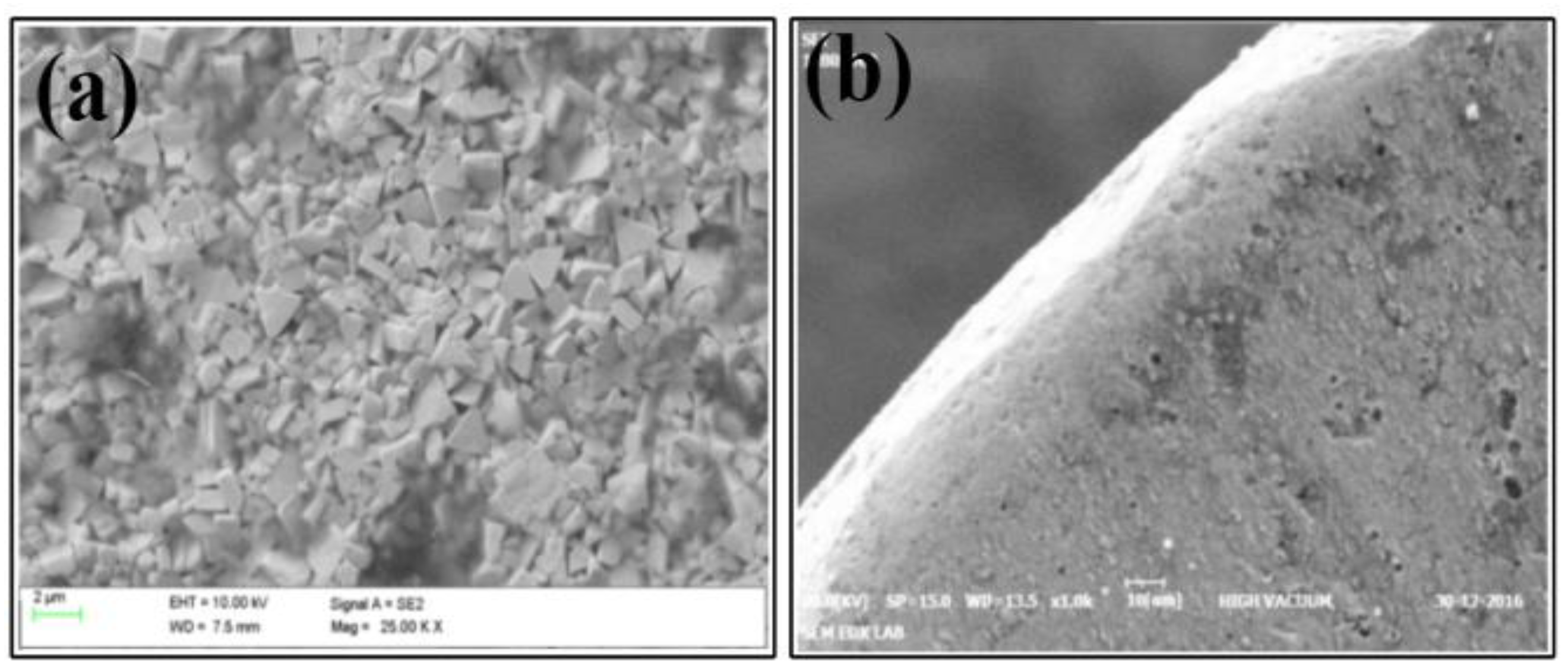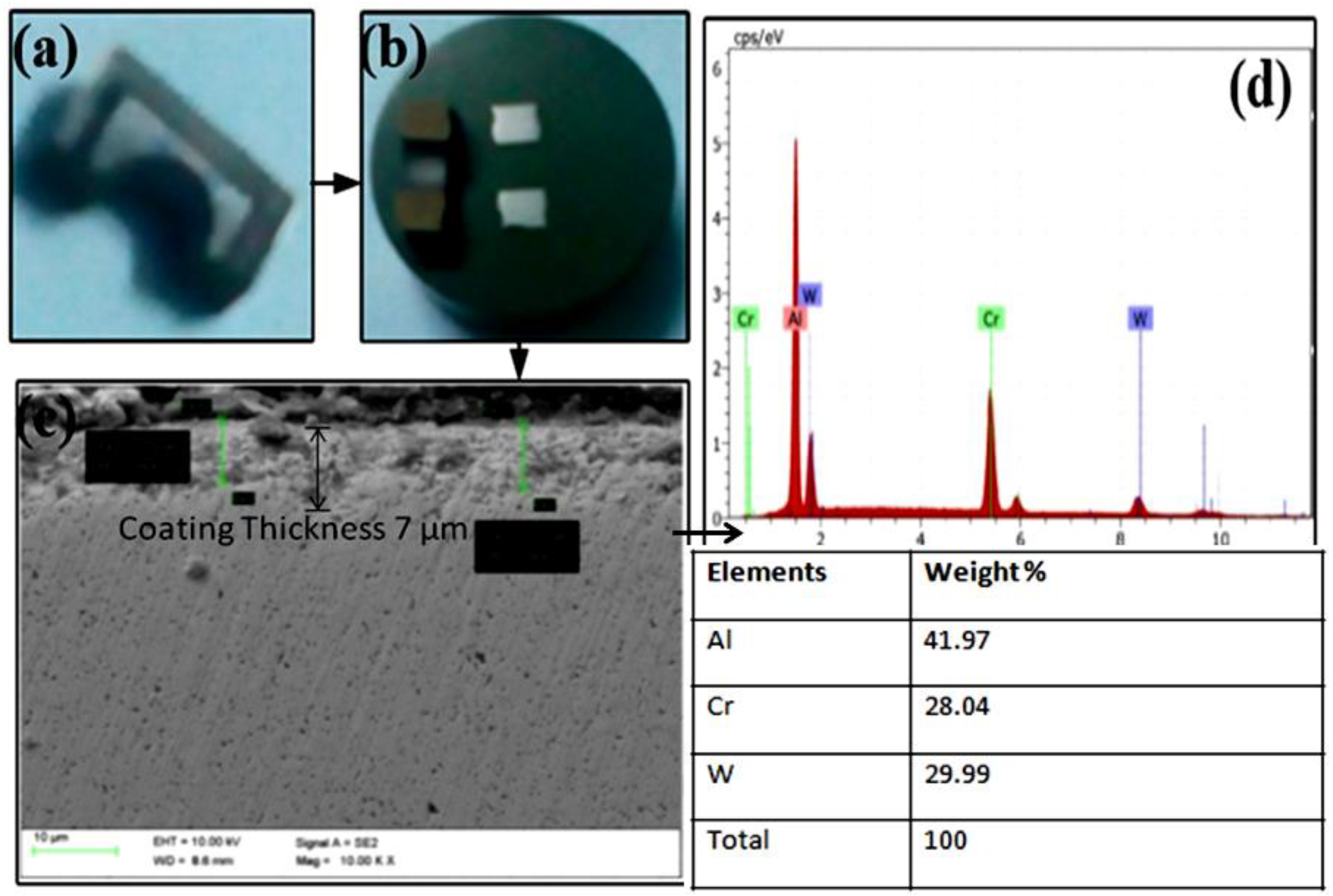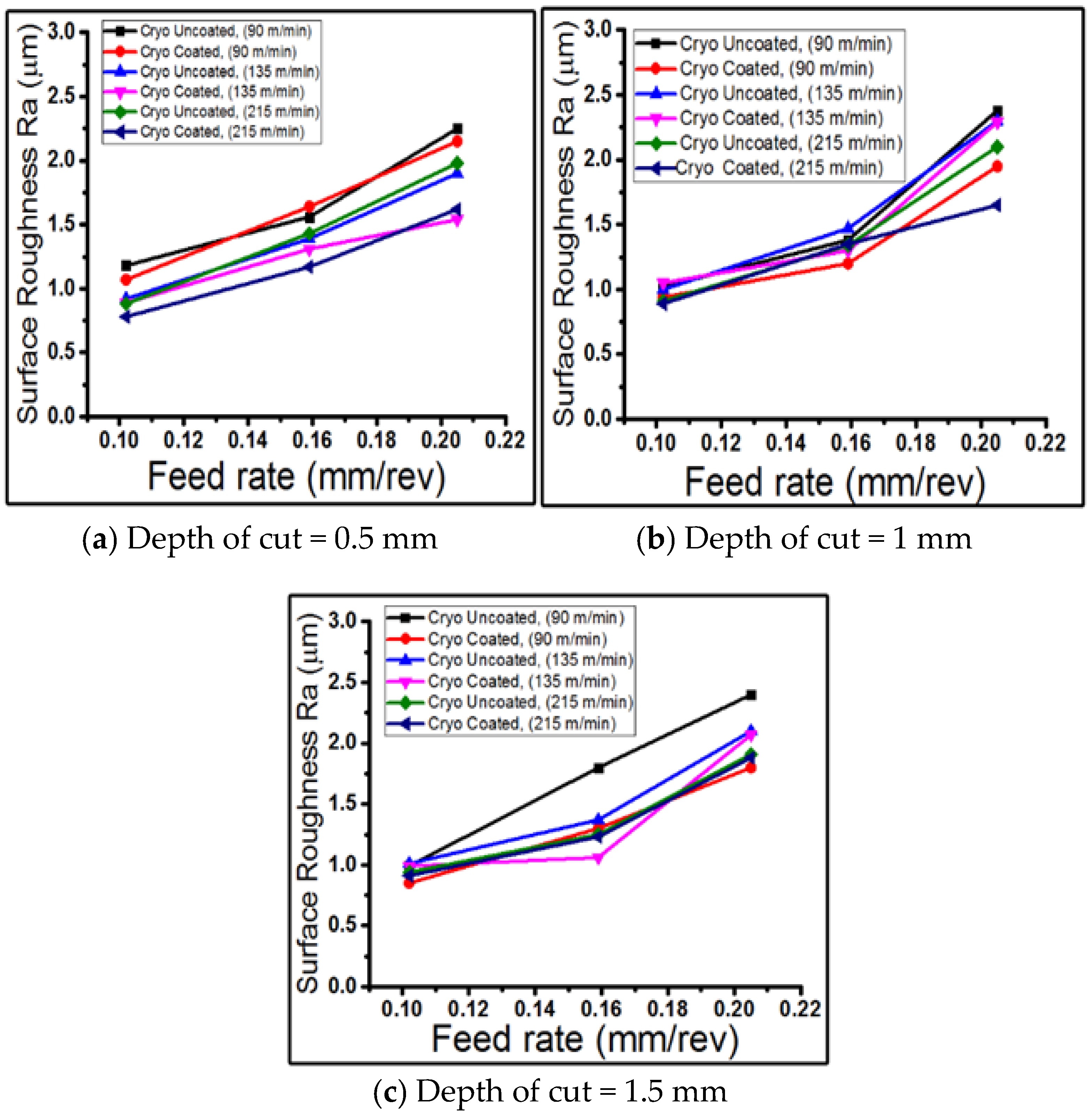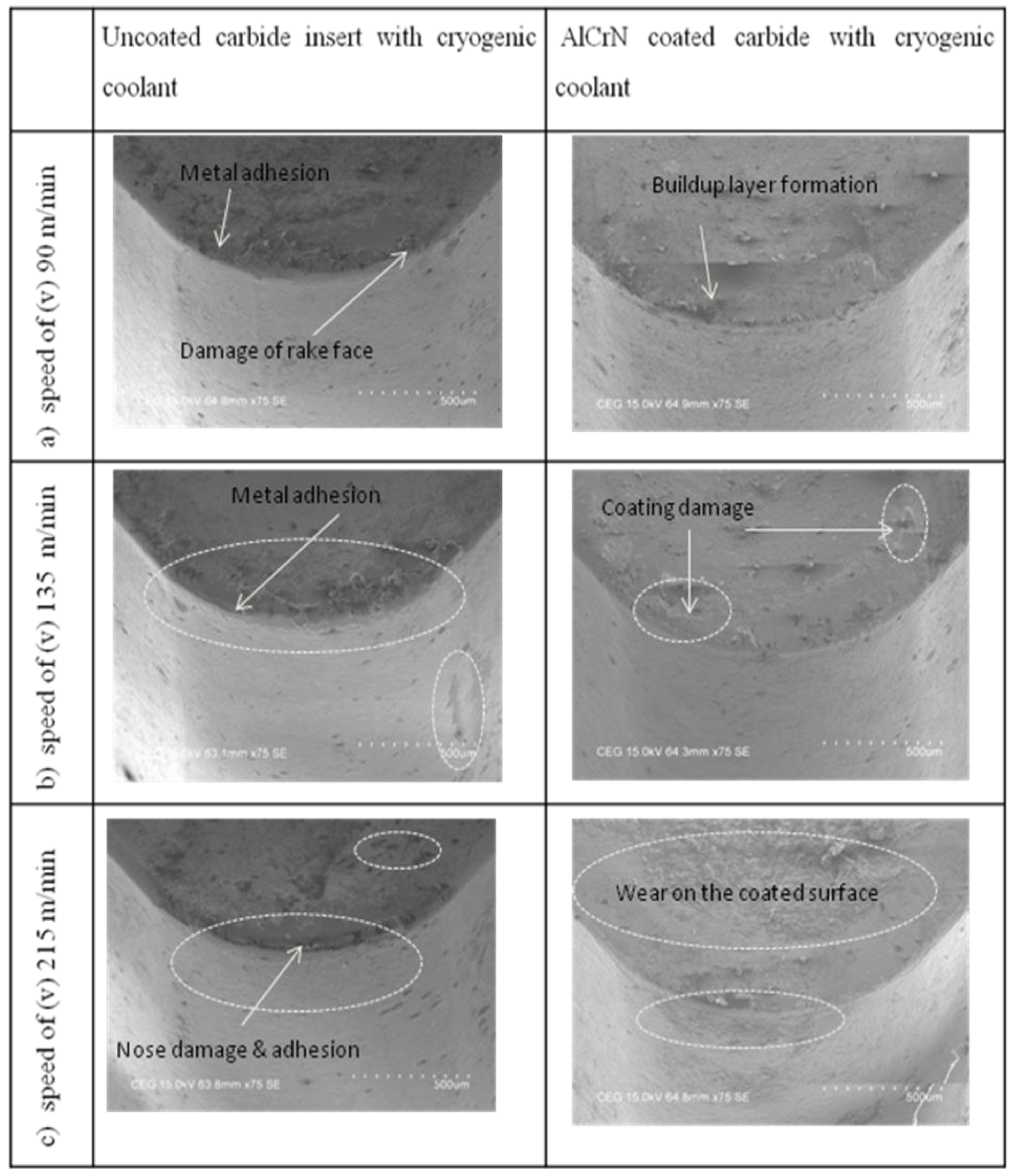Investigation of AlCrN-Coated Inserts on Cryogenic Turning of Ti-6Al-4V Alloy
Abstract
:1. Introduction
2. Materials and Methods
3. Optimization Procedure Involved in the TOPSIS Method
- j—Denotes the output responses;
- i—Denotes the experimental runs.
- wj —weight criteria;
- Number of output response—4.
4. Results and Discussion
Optimization of Cryogenic Turning Performance Using TOPSIS
5. Conclusions
- Cryogenic cooling with a coated cutting tool lowered the main cutting force (Fz) by 1–28% compared to the uncoated insert. The cutting force in the AlCrN-coated cutting tool insert showed a decrease due to the hardness in the coated insert surface.
- The uncoated insert produced irregular surface profile peaks which caused a poor surface finish, and the AlCrN-coated insert showed improvement in the roughness value. Cryogenic cooling with a coated cutting insert caused a reduction in the roughness of the workpiece surface (Ra) by 1–27% over an uncoated insert.
- The best optimal parameters were suggested by TOPSIS at a cutting speed of (Vc) = 215 m/min, feed rate (f) = 0.102 mm/rev, and (doc) = 0.5 mm with the responses Fx 61.6 N, Fy 92.9 N, Fz 72.4 N, Ra 0.78 µm.
- The SEM analysis showed the building of material adhesion and abrasion on the rake and flank face of the insert higher on the uncoated tool insert compared to the AlCrN-coated insert. Analysis of the EDX image and composition on the worn tool insert edge showed the built-up edges on the WC tool inserts and an element composition of Ti, V, Si, C, Al, and W of workpiece material on the uncoated insert edge and AlCrN-coated edge.
- This investigation proves the coated cutting insert with lubrication of cryogenic LN2 coolant created a better surface finish on machined Ti-6Al-4V alloy and less tool wear. This was due to the smaller edge chipping which led to smaller mechanical impact results, higher strength of the tool tip, and heat reduction at the machining zone which improved tool life.
Author Contributions
Funding
Conflicts of Interest
References
- Ezugwu, E.O.; Wang, Z.M. Titanium alloys and their machinability—A review. J. Mater. Process. Technol. 1997, 68, 262–274. [Google Scholar] [CrossRef]
- Yang, X.; Liu, C.R. Machining titanium and its alloys. Int. J. Mach. Sci. Technol. 2007. [Google Scholar] [CrossRef]
- Chauhan, K.V.; Rawal, S.K. A review paper on tribological and mechanical properties of ternary nitride-based coatings. Procedia Technol. 2014, 14, 430–437. [Google Scholar] [CrossRef] [Green Version]
- Bouzakis, K.D.; Michailidis, N.; Skordaris, G.; Bouzakis, E.; Biermann, D.; M’Saoubi, R. Cutting with coated tools: Coating technologies, Characterization methods and performance optimization. CIRP Ann. Manuf. Technol. 2012, 61, 703–723. [Google Scholar] [CrossRef]
- Biksa, A.; Yamamoto, K.; Dosbaeva, G.; Veldhuis, S.C.; Fox-Rabinovich, G.S.; Elfizy, A.; Wagg, T.; Shuster, L.S. Wear behavior of adaptive nano multilayered AlTiN/MexN PVD coatings during machining of aerospace alloys. Tribol. Int. 2010, 43, 1491–1499. [Google Scholar] [CrossRef]
- Anders, N.; Bktash, Z.S.; Richid, M.S. Experimental study and modelling of plastic deformation of cemented carbide tools in turning. Procedia CIRP 2014, 14, 599–604. [Google Scholar]
- Ghani, J.A.; Haron, C.H.C.; Hamdan, S.-H.; Said, A.Y.M.; M Tomadi, S.-H. Failure mode analysis of carbide cutting tools used for machining titanium alloy. Ceram. Int. 2013, 39, 4449–4456. [Google Scholar] [CrossRef]
- Satish, C.; Choudhury, S.K. Investigation on machinability aspects of hardend AISI 4340 steel at different level of hardness busing coated carbide tools. Int. J. Refract. Met. Hard Mater. 2013, 38, 124–133. [Google Scholar]
- Fernandez-abia, A.I.; Barrerio, J.; Fernandez-Larrinoa, J.; Lopez, L.N.; Ferenandez-Valdivieiso, A.; Pereira, O.-M. Behaviour of PVD coatings in the turning of austenitic stainless steels. Procedia Eng. 2014, 63, 133–141. [Google Scholar] [CrossRef] [Green Version]
- Rao, C.J.; Nageswara, R.-D.; Srihari, P. Influence of cutting parameters on cutting force and surface finish in turning operation. Procedia Eng. 2013, 64, 1405–1415. [Google Scholar]
- Jawahir, I.S.; Attia, H.; Biermann, D.; Duflou, J.; Klocke, F.; Meyer, D.; Newman, S.T.; Pusavec, F.; Putz, M.; Rech, J.; et al. Cryogenic manufacturing processes. CIRP Ann. Manuf. Technol. 2016, 65, 713–736. [Google Scholar] [CrossRef]
- Dhananchezian, M.; Pradeepkumar, M.; Sornakumar, T. Cryogenic turning of AISI 304 stainless steel with modified tungsten carbide tool inserts. Mater. Manuf. Process. 2011, 26, 781–785. [Google Scholar] [CrossRef]
- Pramanik, A. Problems and solutions in machining of titanium alloys. Int. J. Adv. Manuf. Technol. 2014. [Google Scholar] [CrossRef]
- Hong, S.-Y. Lubrication mechanism of liquid nitrogen in ecological cryogenic machining. Mach. Sci. Technol. 2007. [Google Scholar] [CrossRef]
- Mirghani, I.A.; Ahmed, F.I.; Abakr, Y.A.; Nurual, A.K.M. Effectiveness of cryogenic machining with modified tool holder. J. Mater. Process. Technol. 2007. [Google Scholar] [CrossRef]
- Nursel, A.O.; Adem, C.; Mahmut, G.; Onur, O. Effect of cutting conditions on wear performance of cryogenically treated tungsten carbide inserts in dry turning of stainless steel. Tribol. Int. 2016, 94, 223–233. [Google Scholar]
- Ghosh, S.; Rao, P.V. Performance evaluation of deep cryogenic processed carbide inserts during dry turning of Nimonic 90 aerospace grade alloy. Tribol. Int. 2017, 115, 392–408. [Google Scholar]
- Safari, H.; Sharif, S.; Izman, S.; Jafari, H.; Kurniawan, D. Cutting Force and Surface Roughness Characterization in Cryogenic High-Speed End Milling of Ti–6Al-4V ELI. Mater. Manuf. Process. 2014, 29, 350–356. [Google Scholar] [CrossRef]
- Waseem, A.; Jianfei, S.; Wuyi, C. Effect of Machining Parameters on Surface Integrity in High Speed Milling of Super Alloy GH4169/Inconel 718. Mater. Manuf. Process. 2016, 31, 620–627. [Google Scholar]
- Ravi, S.; Pradeepkumar, M. Experimental investigations on cryogenic cooling by liquid nitrogen in the end milling of hardened steel. Cryogenics 2011, 51, 509–515. [Google Scholar] [CrossRef]
- Shokrani, A.; Dhokia, V.; Newman, S.T. Investigation of the effects of cryogenic machining on surface integrity in CNC end milling of Ti–6Al–4V titanium alloy. J. Manuf. Process. 2016, 21, 172–179. [Google Scholar] [CrossRef] [Green Version]
- Yuvaraj, N.; Pradeep Kumar, M. Multiresponse Optimization of Abrasive Water Jet cutting process parameters using TOPSIS Approach. Mater. Manuf. Process. 2015, 30, 882–889. [Google Scholar] [CrossRef]
- Jebaraj, M.; Pradeep Kumar, M.; Yuvaraj, N.; Mujibar Rahman, G. Experimental study of the influence of the process parameters in the milling of Al6082-T6 alloy. Mater. Manuf. Process. 2019, 34, 1411–1427. [Google Scholar] [CrossRef]
- Mohanty, A.; Gangopadhyay, S.; Thakur, A. On Applicability of Multilayer Coated Tool in Dry Machining of Aerospace Grade Stainless Steel. Mater. Manuf. Process. 2016, 31, 869–879. [Google Scholar] [CrossRef]
- Emel, K. Nose radius and cutting speed effects during milling of AISI 304 material. Mater. Manuf. Process. 2017, 32, 185–192. [Google Scholar]
- Sivaiah, P.; Chakradhar, D. Influence of cryogenic coolant on turning performance characteristics: A comparison with wet machining. Mater. Manuf. Process. 2017, 32, 1475–1485. [Google Scholar] [CrossRef]
- Zhao, W.; Gong, L.; Ren, F.; Li, L.; Xu, Q.; Khan, M.-A. Experimental study on chip deformation of Ti-6Al-4V titanium alloy in cryogenic cutting. Int. J. Adv. Manuf. Technol. 2018, 96, 4021. [Google Scholar] [CrossRef] [Green Version]
- Salman, P.; Amir, R.; Ibrahim, D.; Nicolescu, M.-C. An experimental investigation on effect of minimum quantity cooling lubrication (MQCL) in machining titanium alloy (Ti6Al4V). Int. J. Adv. Manuf. Technol. 2016, 87, 1371–1386. [Google Scholar] [CrossRef]
- Priarone, P.C.; Klocke, F.; Faga, M.-G.; Lung, D.; Settineri, L. Tool life and surface integrity when turning titanium aluminides with PCD tools under conventional wet cutting and cryogenic cooling. Int. J. Adv. Manuf. Technol. 2016, 85, 807. [Google Scholar] [CrossRef]
- Bai, D.; Sun, J.; Chen, W.; Wang, T. Wear mechanisms of WC/Co tools when machining high-strength titanium alloy TB6 (Ti-10V-2Fe-3Al). Int. J. Adv. Manuf. Technol. 2017, 90, 2863. [Google Scholar] [CrossRef]
- Lin, H.; Wang, C.; Yuan, Y.; Chen, Z.; Wang, Q.; Xiong, W. Tool wear in Ti-6Al-4V alloy turning under oils on water cooling comparing with cryogenic air mixed with minimal quantity lubrication. Int. J. Adv. Manuf. Technol. 2015, 81, 87. [Google Scholar] [CrossRef]
- Rashid, R.R.A.; Palanisamy, S.; Sun, S.; Dargusch, M.-S. Tool wear mechanisms involved in crater formation on uncoated carbide tool when machining Ti6Al4V alloy. Int. J. Adv. Manuf. Technol. 2016, 83, 1457. [Google Scholar] [CrossRef]
- Shi, L. Investigation of tool wear and surface roughness when turning titanium alloy (Ti6Al4V) under different cooling and lubrication conditions. Ferroelectrics 2017. [Google Scholar] [CrossRef]
- Sartori, S.; Taccin, M.; Pavese, G.; Ghiotti, A.; Bruschi, S. Wear mechanisms of uncoated and coated carbide tools when machining Ti6Al4V using LN2 and cooled N2. Int. J. Adv. Manuf. Technol. 2018, 95, 1255. [Google Scholar] [CrossRef]









| Elements | Weight (%) |
|---|---|
| Al | 5.5–6.75 |
| V | 3.5–4.5 |
| Fe | <0.25 |
| C | <0.08 |
| Ti | Remaining |
| Properties | Value |
|---|---|
| Tensile strength | 345 MPa |
| Yield strength | 276 MPa |
| Percent elongation | 22% |
| Hardness | 80 HRB |
| Symbols | Control Factors | Levels | ||
|---|---|---|---|---|
| 1 | 2 | 3 | ||
| T | Tool condition with coolant | UCC | CC | |
| X | Speed (VC)(m/min) | 90 | 135 | 215 |
| Y | Feed (f)(mm/rev) | 0.102 | 0.159 | 0.205 |
| Z | Depth of cut (DOC) (mm) | 0.5 | 1 | 1.5 |
| Experiment Order | T | X | Y | Z | Closeness Alternatives Value | Experiment Order | T | X | Y | Z | Closeness Alternatives Value | ||
|---|---|---|---|---|---|---|---|---|---|---|---|---|---|
| Ci | Rank | Ci | Rank | ||||||||||
| 1 | Uncoated insert with cryogenic coolant (UCC) | 215 | 0.205 | 1.5 | 0.2952 | 50 | 28 | Coated insert with cryogenic coolant (CC) | 215 | 0.205 | 1.5 | 0.3161 | 49 |
| 2 | 215 | 0.159 | 1.5 | 0.4384 | 37 | 29 | 215 | 0.159 | 1.5 | 0.4148 | 40 | ||
| 3 | 215 | 0.102 | 1.5 | 0.6862 | 11 | 30 | 215 | 0.102 | 1.5 | 0.5606 | 30 | ||
| 4 | 135 | 0.205 | 1.5 | 0.1781 | 53 | 31 | 135 | 0.205 | 1.5 | 0.2714 | 52 | ||
| 5 | 135 | 0.159 | 1.5 | 0.3355 | 48 | 32 | 135 | 0.159 | 1.5 | 0.3854 | 44 | ||
| 6 | 135 | 0.102 | 1.5 | 0.4063 | 42 | 33 | 135 | 0.102 | 1.5 | 0.2819 | 51 | ||
| 7 | 90 | 0.205 | 1.5 | 0.1156 | 54 | 34 | 90 | 0.205 | 1.5 | 0.4027 | 43 | ||
| 8 | 90 | 0.159 | 1.5 | 0.5750 | 26 | 35 | 90 | 0.159 | 1.5 | 0.3651 | 46 | ||
| 9 | 90 | 0.102 | 1.5 | 0.5631 | 28 | 36 | 90 | 0.102 | 1.5 | 0.5166 | 32 | ||
| 10 | 90 | 0.102 | 1 | 0.6226 | 20 | 37 | 90 | 0.102 | 1 | 0.5992 | 23 | ||
| 11 | 90 | 0.159 | 1 | 0.5482 | 31 | 38 | 90 | 0.159 | 1 | 0.5018 | 34 | ||
| 12 | 90 | 0.205 | 1 | 0.3662 | 45 | 39 | 90 | 0.205 | 1 | 0.4915 | 35 | ||
| 13 | 135 | 0.102 | 1 | 0.5970 | 25 | 40 | 135 | 0.102 | 1 | 0.6177 | 21 | ||
| 14 | 135 | 0.159 | 1 | 0.4371 | 38 | 41 | 135 | 0.159 | 1 | 0.5154 | 33 | ||
| 15 | 135 | 0.205 | 1 | 0.3440 | 47 | 42 | 135 | 0.205 | 1 | 0.4321 | 39 | ||
| 16 | 215 | 0.102 | 1 | 0.5976 | 24 | 43 | 215 | 0.102 | 1 | 0.6774 | 13 | ||
| 17 | 215 | 0.159 | 1 | 0.6139 | 22 | 44 | 215 | 0.159 | 1 | 0.5738 | 27 | ||
| 18 | 215 | 0.205 | 1 | 0.4805 | 36 | 45 | 215 | 0.205 | 1 | 0.4115 | 41 | ||
| 19 | 215 | 0.205 | 0.5 | 0.6592 | 16 | 46 | 215 | 0.205 | 0.5 | 0.7182 | 8 | ||
| 20 | 215 | 0.159 | 0.5 | 0.7415 | 7 | 47 | 215 | 0.159 | 0.5 | 0.7931 | 3 | ||
| 21 | 215 | 0.102 | 0.5 | 0.7157 | 9 | 48 * | 215 | 0.102 | 0.5 | 0.8378 | 1 | ||
| 22 | 135 | 0.205 | 0.5 | 0.5610 | 29 | 49 | 135 | 0.205 | 0.5 | 0.6848 | 12 | ||
| 23 | 135 | 0.159 | 0.5 | 0.6372 | 18 | 50 | 135 | 0.159 | 0.5 | 0.6602 | 15 | ||
| 24 | 135 | 0.102 | 0.5 | 0.7715 | 5 | 51 | 135 | 0.102 | 0.5 | 0.8212 | 2 | ||
| 25 | 90 | 0.205 | 0.5 | 0.6586 | 17 | 52 | 90 | 0.205 | 0.5 | 0.6249 | 19 | ||
| 26 | 90 | 0.159 | 0.5 | 0.7106 | 10 | 53 | 90 | 0.159 | 0.5 | 0.6673 | 14 | ||
| 27 | 90 | 0.102 | 0.5 | 0.7698 | 6 | 54 | 90 | 0.102 | 0.5 | 0.7822 | 4 | ||
| Tool Conditions with Cryogenic Coolant | Feed Force (Fx) N | Thrust Force (Fy) N | Cutting Force (Fz) N | Surface Roughness (Ra) µm |
|---|---|---|---|---|
| CC | 61.26 | 92.9 | 72.4 | 0.78 |
| UCC | 95.34 | 138 | 98.6 | 0.88 |
© 2019 by the authors. Licensee MDPI, Basel, Switzerland. This article is an open access article distributed under the terms and conditions of the Creative Commons Attribution (CC BY) license (http://creativecommons.org/licenses/by/4.0/).
Share and Cite
Selvam, L.; Murugesan, P.K.; Mani, D.; Natarajan, Y. Investigation of AlCrN-Coated Inserts on Cryogenic Turning of Ti-6Al-4V Alloy. Metals 2019, 9, 1338. https://doi.org/10.3390/met9121338
Selvam L, Murugesan PK, Mani D, Natarajan Y. Investigation of AlCrN-Coated Inserts on Cryogenic Turning of Ti-6Al-4V Alloy. Metals. 2019; 9(12):1338. https://doi.org/10.3390/met9121338
Chicago/Turabian StyleSelvam, Lakshmanan, Pradeep Kumar Murugesan, Dhananchezian Mani, and Yuvaraj Natarajan. 2019. "Investigation of AlCrN-Coated Inserts on Cryogenic Turning of Ti-6Al-4V Alloy" Metals 9, no. 12: 1338. https://doi.org/10.3390/met9121338






